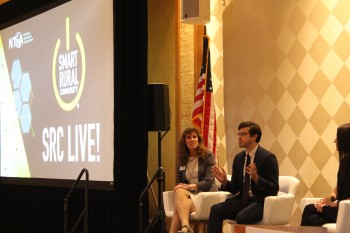Questions that begin with “What if . . .” prevision potential. Introduce possibility. Set an on-ramp to discovery.
Last week, Smart Rural CommunitySM (SRC) met those questions head-on at SRC Live!, a landmark summit that convened rural broadband principals with leadership from other critical industry sectors. And we asked, What if we bridge AI and ag tech with rural broadband networks? What if we apply rural broadband to align K-12 education with regional career opportunities? What if we broaden the use of WiFi enabled “smart dummies” to enhance medical training in rural spaces?
SRC promotes collaboration among rural ISPs and other local leaders to leverage broadband for ag, economic development, education, healthcare, and other vital services. From its inception, SRC has been about more than the network. It is about the power of those networks and rural leadership to be a force for change in rural spaces.
Since 2012, SRC has pursued these goals through the dual focus on “numbers and narrative,” producing educational materials that report empirical data while publicizing case studies that highlight the best practices of locally operated rural broadband providers. Our growing library of research papers, awards for demonstrated best practices, and educational programming promote these ideals and celebrate their accomplishments. SRC Live! moved these conversations from studies to the stage, gathering a broad community of locally operated rural ISPs together with other industry sectors to identify intersections (and solutions) between technology and opportunity for rural spaces.
Designed for exploration and inter-industry education, the summit deployed a “funnel” approach, kicking off with a broad overview of rural broadband issues from the Pew Charitable Trusts and Heartland Forward. This led to sector-specific discussions featuring Alan Morgan, CEO, National Rural Health Association; Allen Pratt, Executive Director, National Rural Education Association; and Kelly Wismer, Chief of Staff, Appalachian Regional Commission.
And then the meat and potatoes: Breakout sessions with ag tech developers who are fusing facial recognition for livestock with online cattle auctions. Economic development experts who position broadband as a key element for community growth. Healthcare advocates pursuing mental health teletherapy in rural spaces. Opportunities for the audience to not simply ask questions but to dive into in full-fledged roundtable-type dialogue with presenters and fellow attendees.
And it’s not that these questions or issues have not been explored previously. Rather, SRC Live! was the transformative gathering at which these seemingly disparate parties came together. “Seemingly disparate” – but only “seemingly,” because in fact the vitality of rural spaces relies upon the interwoven strength of multiple sectors, including education, healthcare, and jobs. All of which rely on robust broadband networks.
And those engaged at the summit hit the bullseye of SRC collaboration:
- A rural broadband operator from Idaho explained how he deployed a mesh network for a local ranch, and then describing the education he gained while doing so, urged state cattleman associations to coordinate with state telecom associations.
- Rising stars shared their perspectives drawn from creating digital literacy and education programs in Tribal lands and emphasized the importance of cultivating the next generation of rural advocates.
- A county government representative, a rural broadband ISP, and a former USDA official shared strategies for critical partnerships to bring broadband to yet-unserved areas.
The meeting was a rural tech Rolodex brought to life. One attendee shared that it was among the best rural industry meetings she had attended because, “It wasn’t just us telecom pros.” And that was the point.
And that’s what matters: Beef represents 17% of the nation’s $391 billion annual cash receipts for ag commodities. A USDA report estimates that the “full potential” of ag tech for crop, livestock, dairy, and poultry farming would increase gross U.S. economic benefits by $47-$65 billion annually. SRC’s recent ag tech paper details these and other gains. And education studies demonstrate that students’ long-term career choices and future earnings are affected by their exposure to broader course offerings while in school. In many rural areas, this exposure is enabled by broadband. SRC reported on this, as well. And an SRC report on telemedicine found significant savings in avoided costs for travel and lost wages, lower hospital costs, and increased revenues for local labs and pharmacies.
And while SRC captures this information, SRC Live! positioned it for live discussion, investigation, and exploration. Kim Harber, SVP, Madison Communications (Staunton, IL), urged attendees to seize SRC not as a “program” but as an initiative and opportunity. And Cassidy Hjelmstad, CEO, SRT Communications, Inc. (Minot, ND), closed the conference by emphasizing the boldness and optimism of rural spaces.
And as boldness is the courage to take steps now, optimism is the hopefulness and confidence we have in the future outcomes of those ventures. And as rural broadband providers take bold steps now, they evidence their faith in a smart rural future. That’s a target for which to aim.
For photos from SRC Live! visit us on Facebook.


